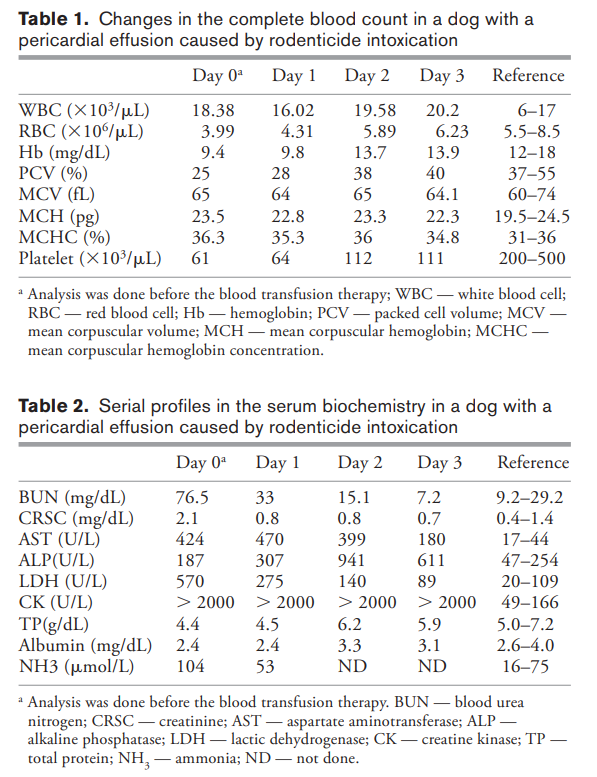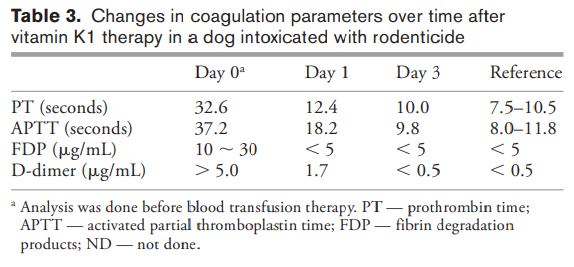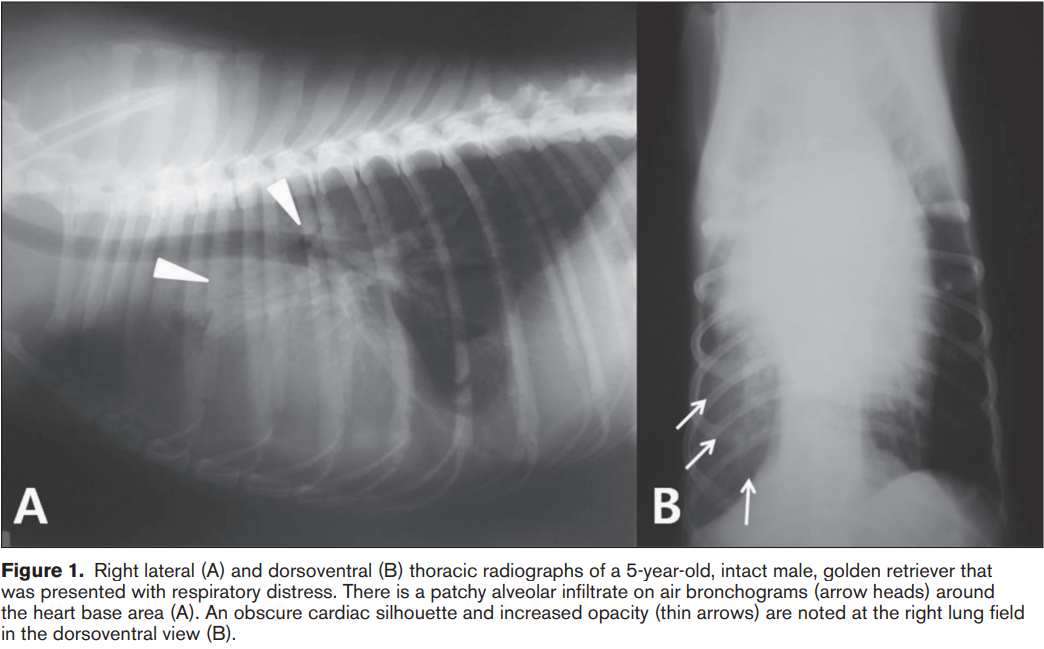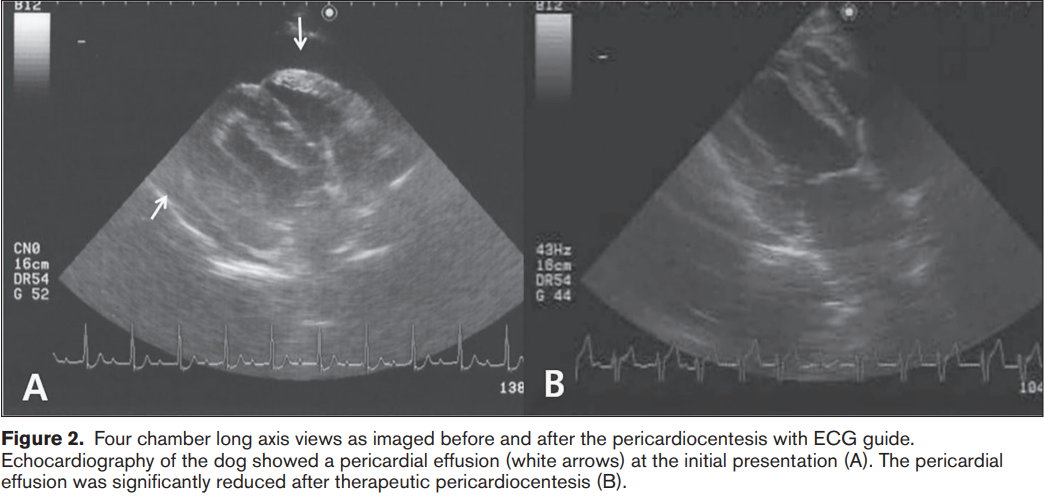2011.PE
目录 |
1 摘要
A 5-year-old, intact male, golden retriever was presented with an acute onset of lethargy and respiratory distress. The dog was diagnosed as having rodenticide intoxication with pericardial effusion. Pericardiocentesis was successfully performed and was followed with a blood transfusion. This case suggests that rodenticide intoxication might cause pericardial effusion in dogs.
一只 5 岁、完整的雄性金毛猎犬出现急性嗜睡和呼吸窘迫。这只狗被诊断为杀鼠剂中毒并伴有心包积液。成功进行了心包穿刺术,随后进行了输血。该病例表明,杀鼠剂中毒可能导致狗心包积液。
2 概述
Although rodenticide intoxication is one of the most common poisonings reported, concerns about its cardiac effects have not been a focus in veterinary medicine. There is only 1 case report of pericardial effusion secondary to the ingestion of anticoagulant rodenticide in a dog (1). Anticoagulant rodenticides include first and second generation compounds. Coumarins such as warfarin, dicoumarol, and coumatetralyl, and indanediones such as valone and pindone belong to the first generation. The second generation compounds include brodifacoum, diphacinone, and bromadiolone. The second generation rodenticides are far more toxic and have a longer duration of action compared with the first generation (2–4). Fatal internal bleeding can be caused by lethal doses of anticoagulants such as brodifacoum, coumatetralyl, or warfarin.
尽管杀鼠剂中毒是报告的最常见的中毒之一,但对其心脏影响的担忧并不是兽医学的重点。只有 1 例继发于狗摄入抗凝剂杀鼠剂的心包积液病例报告 (1)。抗凝剂灭鼠剂包括第一代和第二代化合物。华法林、双香豆素和香豆胯基等香豆素,以及瓦隆和品多内等茚满二酮类药物属于第一代。第二代化合物包括溴敌孢、地磷脂酮和溴敌隆。与第一代灭鼠剂相比,第二代灭鼠剂的毒性要大得多,作用持续时间更长(2-4)。致死剂量的抗凝剂(如溴敌肼、香豆胯基或华法林)可引起致死性内出血。
This report describes a dog with a pericardial effusion associated with coumatetralyl rodenticide intoxication that was successfully treated with pericardiocentesis and standard management.
该报告描述了一只与香豆萘灭鼠剂中毒相关的心包积液的狗,该狗通过心包穿刺术和标准治疗成功治疗。
3 病例描述
A 5-year-old, intact male, golden retriever weighing 30 kg was presented with an acute onset of lethargy and respiratory distress. The owners reported that they had spread several pieces of bread with rodenticide in their backyard about 3 d before clinical signs started. The dog was found at the backyard in lateral recumbency. The owners brought the dog with a bottle of the rodenticide which was identified as coumatetralyl. On physical examination, the dog was lethargic and had a temperature of 39.0°C, labored tachypnea (54 breaths/min), and tachycardia with a heart rate of 150 beats/min. There were no petechiae or ecchymoses on the mucous membrane and skin. Although there were no heart murmurs, mild muffled heart sounds were detected. A complete blood (cell) count (CBC) demonstrated a mild leukocytosis with a stress leukogram and moderate regenerative anemia with moderate thrombocytopenia (Table 1). The serum biochemical analyses revealed a mild azotemia, marked elevation of creatinine kinase (CK), and increased aspartate aminotransferase (AST), hypoalbuminemia, and hypoproteinemia (Table 2). The heartworm antigen and microfilaria tests were negative. The dog’s serum cardiac troponin I (5.42 ng/mL; reference range: 0.0 to 0.7 ng/mL) and creatine kinase isoenzyme MB (28.36 U/L; reference range: 0.3 to 2.9 U/L) were markedly increased. The coagulation panel abnormalities included prolonged prothrombin time (PT) (32.6 s; reference range: 7.5 to 10.5 s), activated partial thromboplastin time (APTT) (37.2 s; reference range: 8.0 to 11.8 s), increased concentration of fibrin degradation products (FDP) (between 10 and 30 mg/mL; reference range: , 5 mg/mL), and elevated D-dimers (. 5.0 mg/mL; reference range: , 0.5 mg/mL) (Table 3).
一只 5 岁、完整的雄性金毛猎犬,体重 30 公斤,出现急性嗜睡和呼吸窘迫。业主报告说,在临床症状开始前大约 3 天,他们在后院撒了几块带有杀鼠剂的面包。这只狗被发现在后院侧卧。主人给狗带来了一瓶杀鼠剂,这种杀鼠剂被鉴定为香豆四烯基。体格检查时,狗狗昏昏欲睡,体温39.0°C,呼吸急促(54次/分),心率150次/分。粘膜和皮肤上没有瘀点或瘀斑。虽然没有心脏杂音,但检测到轻微的低沉心音。全血(细胞)计数(CBC)显示轻度白细胞增多伴应激性白细胞造影和中度再生性贫血伴中度血小板减少症(表 1)。血清生化分析显示轻度氮质血症、肌酐激酶 (CK) 显著升高、天冬氨酸转氨酶 (AST) 升高、低白蛋白血症 (hypoalbuminemia) 和低蛋白血症 (hypoproteinemia)(表 2)。心丝虫抗原和微丝蚴检测呈阴性。狗的血清心肌肌钙蛋白I(5.42 ng/mL;参考范围:0.0-0.7 ng/mL)和肌酸激酶同工酶MB(28.36 U/L;参考范围:0.3-2.9 U/L)显著升高。凝血面板异常包括凝血酶原时间(PT)延长(32.6 s;参考范围:7.5-10.5 s)、活化部分凝血活酶时间(APTT)(37.2 s;参考范围:8.0-11.8 s)、纤维蛋白降解产物(FDP)浓度升高(10至30mg/mL;参考范围:5mg/mL)和D-二聚体升高(5.0mg/mL;参考范围:0.5mg/mL)(表3)。
Moderate thrombocytopenia was confirmed on both a blood smear examination and a CBC panel. The radiographic findings showed signs of a pleural effusion with an interlobar fissure on the right lateral view and air bronchograms around the heart base (Figure 1A). The cardiac silhouette was obscured and the right lung field had increased opacity on the dorsoventral view (Figure 1B). The initial electrocardiographic findings revealed a sinus tachycardia with mild variation of the QRS complexes and ST segment depression; however, no significant electrical alterations were seen. Pleural effusion and pericardial effusion presenting as an echo-free space between the epicardium and the pericardial sac were confirmed on the echocardiographic examination with ECG gating (Figure 2). There were no anatomical or functional abnormalities of the heart except for the pericardial effusion. The initial therapy for 1 d consisted of vitamin K1 (Kaywan; Eisai Co., Tokyo, Japan), 2 mg/kg body weight (BW), subcutaneously, BID, ampicillin (Ampi-1, Dongwon Pharm., Sungnam, Korea, 20 mg/kg BW, intravenously, BID), oxygen supplementation, and normal saline infusion maintained at a consistent rate. A pericardiocentesis was performed at the right hemithorax with the dog in the left lateral recumbent position during preparation of fresh whole blood transfusion. The right lateral thorax was shaved and surgically prepared over the right hemithorax (sternum to mid-thorax, the 2nd to 8th intercostals spaces). A puncture site was locally anesthetized with 2 mL of 2% lidocaine (Lidocaine HCl; Huons Co., Hwaseong City, Korea) after the optimal intercostal space was found by echocardiographic guide. The costochondral junction of the 5th intercostal space was punctured using a 16 gauge over-the-needle catheter (with 2 additional side holes) and 100 mL of hemorrhagic pericardial fluid was removed. The retrieved fluid was analyzed and the results were similar to those of the CBC from blood samples (Table 4). Ventricular tachycardia suddenly developed following the pericardiocentesis. The ventricular tachycardia, however, immediately resolved after administration of a 2% solution of lidocaine hydrochloride (Huons Co.), 2.2 mg/kg, BW, intravenously, once. Then, cryoprecipitate (Korea Animal Blood Bank, Soksho, Korea), 1 mL/kg BW, intravenously and a fresh whole blood transfusion (total 160 mL) were administered to restore the blood volume and various coagulation factors. The dog was monitored for 3 d following the pericardiocentesis and the vitamin K1 treatment (2 mg/kg BW, orally, BID) was continued along with normal saline fluid therapy at a maintenance rate. There was marked improvement during hospitalization based on the CBC, serum biochemistry, ECG, and echocardiographic examination. The coagulopathy panels were re-evaluated at 1 d and 3 d after the vitamin K1 therapy and blood transfusion. The PTs were 12.4 s and 10.0 s, respectively. The APTT were 18.2 s and 9.8 s each. The FDP remained within the normal range. D-dimers were 1.7 mg/mL and , 0.5 ug/mL each (Table 3). The dog was discharged on the 4th day with a prescription for limited activity and vitamin K1 (2 mg/kg, orally, BID) for 14 d. Follow-up 15 d after discharge showed that the dog had remained stable.
中度血小板减少症在血涂片检查和全血细胞计数检查中得到证实。影像学检查结果显示胸腔积液征象,右侧侧位有叶间裂,心脏底部周围有气支气管造影(图1A)。心脏轮廓模糊,背腹侧视野右肺野混浊增加(图1B)。初步心电图结果显示窦性心动过速伴QRS波群轻度变异和ST段压低;但是,没有看到明显的电气变化。胸腔积液和心包积液表现为心外膜和心包囊之间的无回声空间,经心电图门控超声心动图检查证实(图2)。除心包积液外,心脏无解剖学或功能异常。1 d的初始治疗包括维生素K1(Kaywan;卫材株式会社,日本东京),2 mg/kg体重(BW),皮下注射,BID,氨苄西林(Ampi-1,Dongwon Pharm.,Sungnam,Korea,20 mg/kg BW,静脉注射,BID),氧气补充和生理盐水输注保持一致的速率。在准备新鲜全血输注期间,在右侧半胸进行心包穿刺术,狗处于左侧侧卧位。右外侧胸被剃光,并在右半胸(胸骨至胸部中部,第 2 至第 8 肋间隙)上进行手术准备。用 2 mL 2% 利多卡因(Lidocaine HCl;Huons Co., Hwaseong City, Korea)后,通过超声心动图指南找到最佳肋间空间。使用 16 号针头导管(带有 2 个额外的侧孔)刺穿第 5 肋间隙的肋软骨交界处,并取出 100 mL 出血性心包液。对提取的液体进行了分析,结果与血液样本中的全血细胞计数结果相似(表4)。心包穿刺术后突然出现室性心动过速。然而,室性心动过速在静脉注射 2% 盐酸利多卡因溶液 (Huons Co.) 2.2 mg/kg, BW 后立即消退。然后,静脉注射冷沉淀物(韩国动物血库,Soksho,Korea),1 mL/kg BW,并输注新鲜全血(共160 mL),以恢复血容量和各种凝血因子。在心包穿刺术后对狗进行 3 天的监测,并继续维生素 K1 治疗(2 mg/kg BW,口服,BID)以及维持生理盐水治疗。住院期间,全血细胞计数、血清生化、心电图和超声心动图检查均有明显改善。在维生素 K1 治疗和输血后 1 天和 3 天重新评估凝血障碍指标。PT分别为12.4 s和10.0 s。APTT 分别为 18.2 s 和 9.8 s。纤维蛋白降解产物保持在正常范围内。D-二聚体分别为1.7 mg/mL和0.5 ug/mL(表3)。狗在第 4 天出院,处方限制活动和维生素 K1(2 mg/kg,口服,BID)14 天。出院后15天的随访显示,狗保持稳定。
4 讨论
In our case, hemorrhagic pericardial fluid without clots was removed from the pericardial space and analyzed.
在我们的病例中,从心包腔中取出没有凝块的出血性心包积液并进行分析。
A pericardial effusion is a potentially life-threatening problem; it causes an increase in the intrapericardial pressure resulting in varying degrees of hemodynamic compromise (5). The common causes of pericardial effusion in the dog include peritoneopericardial diaphragmatic hernia, congenital cysts, infectious pericarditis, right-sided heart failure, uremia, left atrial rupture, idiopathic pericardial effusion, cardiac neoplasia, and hemorrhage secondary to neoplasia (6). Pericardial effusion caused by rodenticide intoxication has been rarely reported in the veterinary literature. Petrus and Henik (1) reported successful pericardiocentesis in a dog that had ingested brodifacoum rodenticide; they drained the pericardial fluid into the pleural space without retrieving it for cytologic analysis. In our case, hemorrhagic pericardial fluid without clots was removed from the pericardial space and analyzed.
心包积液是一种可能危及生命的问题;它会导致心包内压升高,导致不同程度的血流动力学受损 (5)。狗心包积液的常见原因包括新心包膈疝、先天性囊肿、感染性心包炎、右心力衰竭、尿毒症、左心房破裂、特发性心包积液、心脏肿瘤和继发于肿瘤的出血 (6)。杀鼠剂中毒引起的心包积液在兽医文献中很少见。Petrus 和 Henik (1) 报道了一只摄入了溴敌菌杀鼠剂的狗的心包穿刺术成功;他们将心包积液引流到胸膜腔中,而没有将其取出进行细胞学分析。在我们的病例中,从心包腔中取出没有凝块的出血性心包积液并进行分析。
The rapid and appropriate emergency management involving pericardiocentesis may have contributed to the initial stabilization of the intoxicated dog in this case. The ventricular tachycardia associated with the pericardiocentesis was likely due to irritation of the myocardial surface by the catheter during the procedure and resolved after administration of 2% lidocaine hydrochloride. Despite this complication, these arrhythmias are usually self-limited following the retraction of the needle or catheter (7).
在这种情况下,涉及心包穿刺术的快速和适当的应急管理可能有助于醉酒狗的初步稳定。与心包穿刺术相关的室性心动过速可能是由于手术过程中导管对心肌表面的刺激,并在给予 2% 盐酸利多卡因后消退。尽管有这种并发症,但这些心律失常通常在针头或导管回缩后具有自限性 (7)。
In human medicine, anticoagulants, such as warfarin, have been used for prevention and therapy of coronary artery diseases and previous reports have described the development of pericardial effusions associated with this anticoagulation therapy in humans (8–10). Despite strong evidence favoring a causative role of anticoagulation in the genesis of late cardiac tamponade from intrapericardial bleeding (11,12), there is not a clear answer to the question of whether anticoagulant treatment promotes development of pericardial effusion (13).
Cardiac biomarkers (cTnI and CK-MB) were significantly increased in this dog. According to the study by Shaw et al (14), dogs with pericardial effusion had significantly higher serum levels of cTnI than did normal dogs. Dogs with hemangiosarcoma had much higher concentrations of cTnI (2.77 ng/dL; range: 0.09 to 47.18 ng/dL) than did dogs with idiopathic pericardial effusion (0.05 ng/dL; range: 0.03 to 0.09 ng/dL)(P , 0.001) (14). Our data were similar to the values obtained with idiopathic pericardial effusion. Gastrointestinal bleeding could be a possible cause of elevated serum urea nitrogen, CRSC, ALP, and NH3. Increased serum AST, LDH, and CK might be caused by tissue damage in this case.
在人类医学中,抗凝剂(如华法林)已被用于预防和治疗冠状动脉疾病,以前的报道描述了与这种抗凝治疗相关的人类心包积液的发展 (8–10)。尽管有强有力的证据表明抗凝治疗在心包内出血导致晚期心包填塞的发生中具有致病作用 (11,12),但对于抗凝治疗是否促进心包积液发展的问题尚无明确的答案 (13)。 这只狗的心脏生物标志物(cTnI 和 CK-MB)显着增加。根据 Shaw 等人 (14) 的研究,心包积液狗的血清 cTnI 水平明显高于正常狗。血管肉瘤患者的cTnI浓度(2.77 ng/dL;范围:0.09-47.18 ng/dL)远高于特发性心包积液(0.05 ng/dL;范围:0.03-0.09 ng/dL)(P,0.001)(14)。我们的数据与特发性心包积液获得的值相似。消化道出血可能是血清尿素氮、CRSC、ALP 和 NH3 升高的可能原因。在这种情况下,血清 AST、LDH 和 CK 升高可能是由组织损伤引起的。
In veterinary medicine, if a pericardial effusion is suspected as a result of rodenticide intoxication, it is important for veterinarians to confirm the presence of the pericardial effusion by using echocardiography, and then perform a routine pericardiocentesis for a better therapeutic prognosis.
在兽医学中,如果怀疑杀鼠剂中毒导致心包积液,兽医必须使用超声心动图确认心包积液的存在,然后进行常规心包穿刺术以获得更好的治疗预后。



